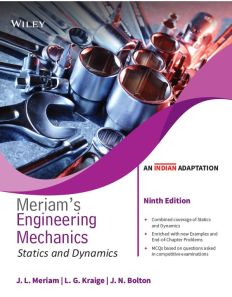Engineering Mechanics Statics and Dynamics, 9ed, (An Indian Adaptation)
ISBN: 9789354248566
1044 pages
Publication Year: 2021
For more information write to us at: acadmktg@wiley.com

Description
Meriam's Engineering Mechanics is a classic textbook for the first engineering course in mechanics that has provided a solid foundation of mechanics principles for more than 60 years. Known for its accuracy, clarity, and dependability, it is written in a style which is both concise and friendly, with major emphasis on basic principles and methods. This text continues to help students develop their problem-solving skills with an extensive variety of engaging problems related to engineering design. It effectively demonstrates both the cohesiveness of the relatively few fundamental ideas and the great variety of problems which these few ideas will solve.
Foreword
Preface to the Adapted Edition
Preface
Acknowledgments
Part I Statics
1 Introduction to Statics
2 Force Systems
2.1 Introduction
2.2 Force
2.3 Rectangular Components
2.4 Moment
2.5 Couple
2.6 Resultants
2.7 Rectangular Components
2.8 Moment and Couple
2.9 Resultants
2.10 Chapter Review
3 Equilibrium
3.1 Introduction
3.2 System Isolation and the Free-Body Diagram
3.3 Equilibrium Conditions
3.4 Equilibrium Conditions
3.5 Chapter Review
4 Structures
4.1 Introduction
4.2 Plane Trusses
4.3 Method of Joints
4.4 Graphical Method
4.5 Method of Sections
4.6 Space Trusses
4.7 Frames and Machines
4.8 Chapter Review
5 Distributed Forces: Center of Mass, Centroid, and Moment of Inertia
5.1 Introduction
5.2 Center of Mass
5.3 Centroids of Lines, Areas, and Volumes
5.4 Composite Bodies and Figures; Approximations
5.5 Theorems of Pappus
5.6 Area Moments of Inertia
5.7 Mass Moments of Inertia
5.8 Beams—External Effects
5.9 Beams—Internal Effects
5.10 Chapter Review
6 Friction
6.1 Introduction
6.2 Types of Friction
6.3 Dry Friction
6.4 Wedges
6.5 Screws
6.6 Journal Bearings
6.7 Thrust Bearings; Disk Friction
6.8 Flexible Belts
6.9 Rolling Resistance
6.10 Chapter Review
7 Virtual Work
7.1 Introduction
7.2 Work
7.3 Equilibrium
7.4 Potential Energy and Stability
7.5 Chapter Review
Part II Dynamics
Part IIA: Dynamics of Particles
8 Introduction to Dynamics
8.1 History and Modern Applications
8.2 Solving Problems in Dynamics
8.3 Chapter Review
9 Kinematics of Particles
9.1 Introduction
9.2 Rectilinear Motion
9.3 Plane Curvilinear Motion
9.4 Rectangular Coordinates (x-y)
9.5 Normal and Tangential Coordinates (n-t )
9.6 Polar Coordinates (r-q)
9.7 Space Curvilinear Motion
9.8 Relative Motion (Translating Axes)
9.9 Constrained Motion of Connected Particles
9.10 Chapter Review
10 Kinetics of Particles
10.1 Introduction
10.2 Newton’s Second Law
10.3 Equation of Motion and Solution of Problems
10.4 Rectilinear Motion
10.5 Curvilinear Motion
10.6 Work and Kinetic Energy
10.7 Potential Energy
10.8 Introduction
10.9 Linear Impulse and Linear Momentum
10.10 Angular Impulse and Angular Momentum
10.11 Introduction
10.12 Impact
10.13 Central-Force Motion
10.14 Relative Motion
10.15 Chapter Review
11 Kinetics of Systems of Particles
11.1 Introduction
11.2 Generalized Newton’s Second Law
11.3 Work-Energy
11.4 Impulse-Momentum
11.5 Conservation of Energy and Momentum
11.6 Steady Mass Flow
11.7 Variable Mass
11.8 Chapter Review
Part IIB: Dynamics of Rigid Bodies
12 Plane Kinematics of Rigid Bodies
12.1 Introduction
12.2 Rotation
12.3 Absolute Motion
12.4 Relative Velocity
12.5 Instantaneous Center of Zero Velocity
12.6 Relative Acceleration
12.7 Motion Relative to Rotating Axes
12.8 Chapter Review
13 Plane Kinetics of Rigid Bodies
13.1 Introduction
13.2 General Equations of Motion
13.3 Translation
13.4 Fixed-Axis Rotation
13.5 General Plane Motion
13.6 Work-Energy Relations
13.7 Acceleration from Work-Energy; Virtual Work
13.8 Impulse-Momentum Equations
13.9 Chapter Review
14 Introduction to Three-Dimensional Dynamics of Rigid Bodies
14.1 Introduction
14.2 Translation
14.3 Fixed-Axis Rotation
14.4 Parallel-Plane Motion
14.5 Rotation about a Fixed Point
14.6 General Motion
14.7 Angular Momentum
14.8 Kinetic Energy
14.9 Momentum and Energy Equations of Motion
14.10 Parallel-Plane Motion
14.11 Gyroscopic Motion: Steady Precession
14.12 Chapter Review
15 Vibration and Time Response
15.1 Introduction
15.2 Free Vibration of Particles
15.3 Forced Vibration of Particles
15.4 Vibration of Rigid Bodies
15.5 Energy Methods
15.6 Chapter Review
Appendix A Introduction to Analytical Mechanics
Appendix B Selected Topics of Mathematics
Appendix C Useful Tables
Index
Problem Answers

